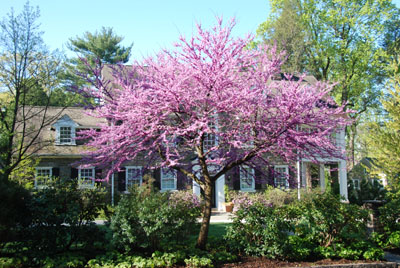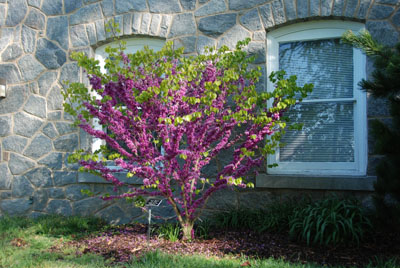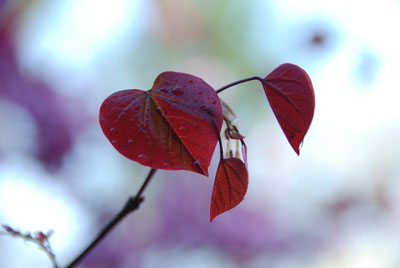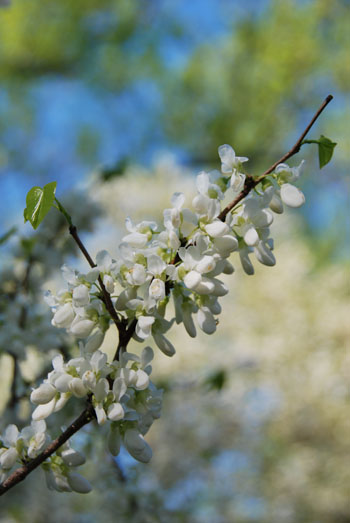Cercis canadensis

There is nothing more exciting than taking a hike and stumbling into a patch of the eastern redbud, Cercis canadensis. It is quite common as an understory tree, with an extensive range from east coast to the central United States. Right now the vivid purple flowers are abundant at the Scott Arboretum. Although the straight species is exceptional by itself, there are several cultivars blooming in the Scott Arboretum that I would like to comment on.
The reason I love this small tree is its adaptability to sun exposure. Naturally occurring in the understory throughout Appalachia, it is a nice candidate for confined spaces that may not receive direct sunlight, most notably alleyways or tiny yards that must conserve space for walkways. Personally, I think every homeowner that has an ideal woodland edge should interplant young eastern redbuds en masse. It is a worthy investment for a spectacular spring show. The redbud itself isn’t very large, only reaching twenty to thirty feet in height, with a slightly smaller width.

Cercis chinensis 'Don Egolf''. photo credit: S. Keitch
There are several cultivars of redbud, some of which I love, while others I have yet to come to terms with. One of the two cultivars that I would use as a focal points is: Cercis canadensis ‘Hearts of Gold’ which has typical redbud attributes, but the foliage is an outrageous chartreuse color. Another is Cercis chinensis ‘Don Egolf’, named after the shrub breeder from the U.S. National Arboretum, Dr. Donald Egolf. It may be the most potent redbud in the collection as the entire compact plant is smothered from the branch tips to the trunk in flowers. Everyone seems to exclaim with awe upon viewing either of these cultivars.

Foliage of Cercis canadensis 'Forest Pansy'. photo credit: S. Keitch
Other hot examples in the collection are the plantings of Cercis canadensis ‘Appalachian Red’ in the Glade Garden. C. ‘Appalachian Red’ is a vivid red to mauve tone. If you prefer more subtle characteristics, then the white flowering form, C. canadensis ‘Alba’ may be to your liking. Personally, I think the purple leafed form, C. canadensis ‘Forest Pansy’ is one of the top choices. The rich purple foliage emerges to extend aesthetic appeal and varies from green to cool purple depending on the leaves relative position to the outer portion of the canopy.
Another subtle redbud form is the tightly branched Cercis chinensis ‘Ace Of Hearts’. The foliage is arranged along stout branches that zigzag from leaf to leaf, forming two columns of tightly arranged leaves. The foliage and overall size of this cultivar is diminutive in comparison to the native species.

Cercis canadensis 'Alba'. photo credit: S. Keitch
Whether you are driving along the highway or strolling through the Scott Arboretum during the next week, be sure to notice the spectacular purple flowers punctuating the ever-changing spring landscape.





Matthew
Posted at 10:52h, 23 AprilThanks for posting such a great article about one of my favorite trees, the state tree of Oklahoma! It reminds me of home everytime I see it. It is an excellent tree in the garden and I often wonder why it is not used more. I did not know about the ‘Don Egulf’ cultivar; that is quite a spring show. Cheers!
Christine B.
Posted at 14:04h, 23 AprilIf I can just convince a Cercis that it would be happy here, I plant a glade of them. I’m a little ashamed to admit I’ve never seen one in bloom in the flesh.
Christine in Alaska
Louise Eliason, Coordinator, Greater Philadelphia Gardens
Posted at 18:09h, 26 AprilGreater Philadelphia Gardens’ Member Becky Roberts submitted your article to be featured on our web and newsletter this week ! Well done, Sam! Visit our website and become our Facebook fan, too.
Samuel Keitch
Posted at 08:47h, 27 AprilHello Matthew, Christine, and Louise!
Matthew- there are a several cultivars and species that I left out of the blog, but I would like to mention a few more! Another overwhelmingly bright cultivar, which has a tight habit like ‘Don Egulf’, is C. yunnanensis ‘Celestial Plum’. If you would like to see some other variations in colors, look up for ‘Tennessee Pink’ and ‘Pauline Lily’. There is also a weeping cultivar called ‘Covey’, but I have mixed feelings regarding weeping trees.
Christine- I don’t know where you live in Alaska, but I think that you would be alright attempting to plant a redbud along the coast. C. canadensis may be hardy in Zone 4, which would include the southern coast of Alaska. I think you should give it a try!
Louise- Thank you! I appreciate you including the blog!
Thank you all for your interest-
Sam
Rita
Posted at 15:22h, 18 MayI fell across this article while trying to find which 14 states the Don Egolf redbud was tested in. I am in zone 5 – Denver and would love to have this shrub. I am tempted to buy it and just give it a try. I love redbuds, and love reading about them. Thanks for a nice article.
Rita in Denver
Heather in Melbourne Australia
Posted at 02:10h, 15 NovemberHi Sam
I had a Forest Pansy in my previous home which did marvellously well and was a much talked about tree. Now they have become very popular here in Melbourne Australia. Since I’ve just begun my new garden I have just planted a stunning “Hearts of Gold” as a specimen tree and it is already attracting attention for it’s beautiful leaves. What will they say when they see it in Spring! Can’t wait! I’m completely in love with it and so what an apt name!
ps – I also have a small Cercis Oklahoma which has mid green leaves so I’m expecting a Spring spectacular.
Mary Tipping
Posted at 10:14h, 17 NovemberHeather,
That is great to know that you too enjoy Cercis ‘Hearts of Gold’. Cercis canadensis ‘Merlot’ is a great substitute for Cercis c. ‘Forest Pansy’, and the foliage stays deep burgundy during warm weather (unlike Cercis c. ‘Forest Pansy’).
Mary Tipping
Scott Arboretum Curator & Plant Recorder